SNOSB43C September 2011 – November 2016 LM3560
PRODUCTION DATA.
- 1 Features
- 2 Applications
- 3 Description
- 4 Revision History
- 5 Pin Configuration and Functions
- 6 Specifications
-
7 Detailed Description
- 7.1 Overview
- 7.2 Functional Block Diagram
- 7.3
Feature Description
- 7.3.1 Power Amplifier Synchronization (Tx1)
- 7.3.2 Independent LED Control
- 7.3.3 Hardware Torch
- 7.3.4 Fault Protections
- 7.3.5 Input Voltage Monitor
- 7.3.6 Last Flash Register
- 7.3.7 LED Voltage Monitor
- 7.3.8 ADC Delay
- 7.3.9 Flags Register and Fault Indicators
- 7.4
Device Functional Modes
- 7.4.1 Start-Up (Enabling the Device)
- 7.4.2 Pass Mode
- 7.4.3 Flash Mode
- 7.4.4 Torch Mode
- 7.4.5 Privacy Indicator Mode
- 7.4.6 GPIO1 Mode
- 7.4.7 TX2/INT/GPIO2
- 7.4.8 TX2 Mode
- 7.4.9 GPIO2 Mode
- 7.4.10 Interrupt Output (INT Mode)
- 7.4.11 NTC Mode
- 7.4.12 Alternate External Torch (AET) Mode
- 7.4.13 Automatic Conversion Mode
- 7.4.14 Manual Conversion Mode
- 7.5 I2C-Compatible Interface
- 7.6
Register Descriptions
- 7.6.1 Enable Register (Address 0x10)
- 7.6.2 Privacy Register (Address 0x11)
- 7.6.3 Indicator Register (Address 0x12)
- 7.6.4 Indicator Blinking Register (Address 0x13)
- 7.6.5 Privacy PWM Period Register (Address 0x14)
- 7.6.6 GPIO Register (Address 0x20)
- 7.6.7 LED Forward Voltage ADC (VLED Monitor Register, Address 0x30)
- 7.6.8 ADC Delay Register (Address 0x31)
- 7.6.9 VIN Monitor Register (Address 0x80)
- 7.6.10 Last Flash Register (Address 0x81)
- 7.6.11 Torch Brightness Register Descriptions (Address 0xA0)
- 7.6.12 Flash Brightness Register (Address 0xB0)
- 7.6.13 Flash Duration Register (Address 0xC0)
- 7.6.14 Flags Register (Address 0xD0)
- 7.6.15 Configuration Register 1 (Address 0xE0)
- 7.6.16 Configuration Register 2 (Address 0xF0)
- 8 Application and Implementation
- 9 Power Supply Recommendations
- 10Layout
- 11Device and Documentation Support
- 12Mechanical, Packaging, and Orderable Information
7 Detailed Description
7.1 Overview
The LM3560 is a high-power white-LED flash driver capable of delivering up to 2 A of LED current into a single LED or up to 1 A into two parallel LEDs. The device incorporates a 2-MHz constant frequency, a synchronous boost converter, and two high-side current sources to regulate the LED current over the 2.5-V to 5.5-V input voltage range.
During operation when the output voltage is greater than VIN – 150 mV the boost converter switches and maintains at least 300 mV across both current sources (LED1 and LED2). This minimum headroom voltage ensures that the current sources remain in regulation. When the input voltage rises above the LED voltage + current source headroom voltage, the device stops switching and turns the PFET on continuously (pass mode). In pass mode the difference between (VIN – ILED × RON_P) and the voltage across the LEDs is dropped across the current sources.
Four hardware control pins provide control of the LM3560. These include a hardware flash enable (STROBE), dual flash Interrupt inputs (TX1 and TX2) designed to interrupt the flash pulse during high battery current conditions, and a logic high hardware enable (HWEN) that can be pulled low to rapidly place the device into shutdown. Additional features of the LM3560 include an internal 4-bit ADC for LED voltage monitoring, an internal comparator for LED thermal sensing via an external NTC thermistor, an input voltage monitor that can reduce the flash current during input undervoltage conditions, a low-power message indicator LED current source, and a mode for utilizing the flash LEDs as a privacy indicator.
Control of the LM3560 is done via an I2C-compatible interface. This includes adjustment of the flash and torch current levels, adjustment of the indicator LED currents, changing the flash timeout duration, changing the switch current limit, and reading back the ADC results. Additionally, there are 8 flag bits that indicate flash current time-out, LED overtemperature, LED failure (LED short or output OVP condition), device thermal shutdown, VIN undervoltage condition, VIN flash monitor undervoltage condition, and the occurrence of a TX1 or TX2 interrupt.
7.2 Functional Block Diagram
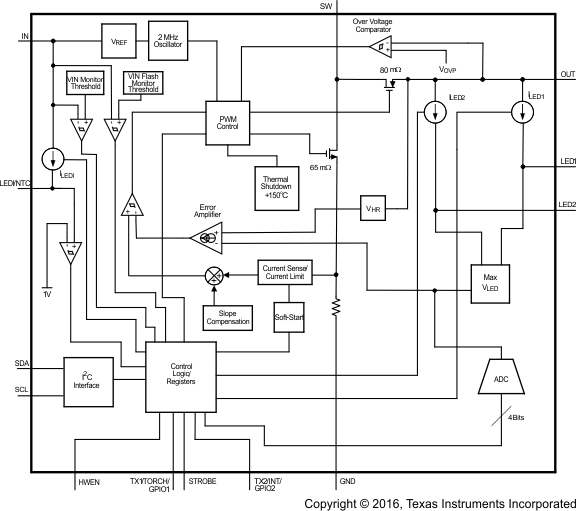
7.3 Feature Description
7.3.1 Power Amplifier Synchronization (Tx1)
The TX1/TORCH/GPIO1 pin has a triple function. With configuration register 1 bit [7] = 0 (default) TX1/TORCH/GPIO1 is a power amplifier synchronization input (TX1 mode). This mode is designed to reduce the flash LED current when TX1 is driven high (active high polarity) or driven low (active low polarity). When the LM3560 is engaged in a flash event and TX1/TORCH is driven high, the active current sources (LED1 and/or LED2) are forced into torch mode at the programmed torch current setting. If TX1 is then pulled low before the flash pulse terminates, the LED current returns to the previous flash current level. At the end of the flash timeout, whether the TX1/TORCH pin is high or low, the LED current turns off.
The polarity of TX1 can be changed from active high to active low by writing a 0 to bit [5] of Configuration Register 1. With this bit set to 0 the LM3560 is forced into torch mode when TX1/TORCH is pulled low. Figure 21 details the functionality of the TX1 Interrupt.
7.3.1.1 TX1 Shutdown
TX1 also has the capability to force shutdown. Bit [4] of configuration register 2 set to a 1, changes TX1 from a force torch when active to a force shutdown when active. For example, if TX1/TORCH/GPIO1 is configured for TX1 mode with active high polarity, and bit[4] of configuration register 2 is set to 1, then when TX1 is driven high, the active current sources (LED1 and/or LED2) is forced into shutdown. Once the active current sources are forced into shutdown by activating TX1, the current sources can only be re-enabled into flash mode if TX1 is pulled low and the flags register is read back. If only the flags register is read back and TX1 is kept high the device is re-enabled into torch mode and not shutdown. This occurs because the TX1 shutdown feature is an edge-triggered event. With active high polarity the TX1 shutdown requires a rising edge at TX1 in order to force the current source into shutdown. Once shut down, it takes a read back of the flags register and another rising edge at TX1 to force shutdown again. Figure 34 details the different responses of the TX1 shutdown mode.
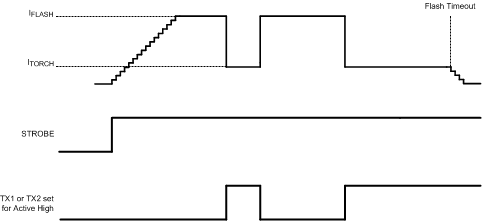 Figure 21. TX1 or TX2 Interrupt (Force Torch) Response
Figure 21. TX1 or TX2 Interrupt (Force Torch) Response
7.3.2 Independent LED Control
Bits [4:3] of the eenable register provide for independent turnon and turnoff of the LED1 or LED2 current sources. Once enabled, the LED current is adjusted by writing to the torch brightness or flash brightness registers depending on whether flash or torch mode is selected. Both the torch brightness and the flash brightness registers provide for independent current programming for the LED currents in either LED1 or LED2. (See Torch Brightness Register Descriptions (Address 0xA0) and Flash Brightness Register (Address 0xB0).)
7.3.3 Hardware Torch
With configuration register 1 Bit [7] = 1, TX1/TORCH/GPIO1 is configured as a hardware torch mode enable. In this mode, a high at TX1/TORCH turns on the LED current at the programmed torch current setting. The STROBE input and I2C-enabled flash takes precedence over torch mode. In hardware torch mode, both LED1 and LED2 current sources turn off after a flash event and configuration register 1 Bit [7] is reset to 0. In this situation, to re-enter torch mode via hardware torch, the hardware torch enable bit (configuration register 1 Bit [7]) must be reset to 1. Figure 22 details the functionality of hardware torch mode.
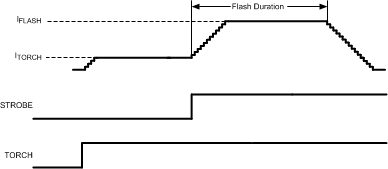 Figure 22. Hardware Torch Mode
Figure 22. Hardware Torch Mode
7.3.4 Fault Protections
7.3.4.1 Overvoltage Protection
The output voltage is limited to typically 5 V (5.075 V maximum). In situations such as the current source open, the LM3560 raises the output voltage to try to keep the LED current at its target value. When VOUT reaches 5 V, the overvoltage comparator trips and turns off both the internal NFET and PFET. When VOUT falls below 4.8 V (typical), the LM3560 begins switching again.
7.3.4.2 Current Limit
The LM3560 features 4 selectable current limits: 1.6 A, 2.3 A, 3 A, and 3.6 A. These are programmable through the I2C-compatible interface via bits [6:5] of the flash duration register. When the current limit is reached, the LM3560 stops switching for the remainder of the switching cycle.
Because the current limit is sensed in the NMOS switch there is no mechanism to limit the current when the device operates in pass mode. In situations where there could potentially be large load currents at OUT, and the LM3560 device is operating in pass mode, the load current must be limited to 3 A. In boost mode or pass mode if VOUT falls below approximately 2.3 V, the device stops switching and the PFET operates as a current source, limiting the current to typically 350 mA. This prevents damage to the LM3560 and excessive current draw from the battery during output short-circuit conditions.
7.3.4.3 Flash Timeout
The flash-timeout period sets the amount of time that the flash current is being sourced from current sources LED1 and LED2. Bits [4:0] of the flash duration register set the flash-timeout period. There are 32 different flash-timeout durations in steps of 32 ms giving a flash timeout range of 32 ms to 1024 ms (see Table 15).
7.3.4.4 Indicator LED/Thermistor (LED1/NTC)
The LEDI/NTC pin serves a dual function: either as a programmable LED message indicator driver or as a comparator input for negative temperature coefficient (NTC) thermistors.
7.3.4.4.1 Message Indicator Current Source (LEDI/NTC)
LEDI/NTC is configured as a message indicator current source by setting configuration register 1 bit [4] = (0) default. The indicator current source is enabled/disabled via the enable register bit [6] = (1). Bit [7] of the enable register enables the message Indicator in blink mode. If the message indicator is set for blinking mode, the pattern programmed into the indicator register, and indicator blinking register is output on the Indicator current source.
The indicator blinking register controls the following (see Table 6):
- Number of blank periods (BLANK #). This has 16 settings. tBLANK = tACTIVE × BLANK# , where tACTIVE = tPERIOD × PERIOD#
- Pulse width (tPULSE) has 16 settings between 0 and 480 ms in steps of 32 ms. The pulse width is the duration that the indicator current is at its programmed set point at the end of the ramp-up time.
The indicator register controls the following (see Table 5):
- Indicator current level (IIND). There are 8 indicator current levels from 2.25 mA to 18 mA in steps of 2.25 mA.
- Number of periods (PERIOD #). This has 8 steps. A period (tPERIOD) is found by
tPERIOD = tR + tF + 2 x tPULSE. (see Figure 23 for indicator timing). - Ramp times (tR or tF) for turnon and turnoff of the indicator current source. Four programmable times of 78 ms, 156 ms, 312 ms, and 624 ms are available. The ramp times apply for both ramp-up and ramp-down and are not independently changeable.
 Figure 23. Message Indicator Timing Diagram
Figure 23. Message Indicator Timing Diagram
7.3.4.4.1.1 Message Indicator Example 1 (Single Pulse With Dead Time):
As an example, to set up the message indicator for a 312-ms ramp-up and ramp-down, 192-ms pulse width, and 1 pulse followed by a 5-s delay. The indicator settings is as follows. tR = tF = 312 ms, tWIDTH = 192 ms (tPERIOD = 312 ms × 2 + 192 ms × 2 = 1016 ms). BLANK# setting is: 5s/1016 ms × 1 (PERIOD# = 1). Giving a BLANK# setting of 5. The resulting waveform appears as:
 Figure 24. Message Indicator Example 1
Figure 24. Message Indicator Example 1
7.3.4.4.1.2 Message Indicator Example 2 (Multiple Pulses With Dead Time):
Another example has the same tR, tF, tPULSE, and tBLANK times as before, but this time the PERIOD# is set to 3. Now the tACTIVE time is tPERIOD × 3 = 1016 ms × 3 = 3048 ms. This results in a blank time of tBLANK = tACTIVE × BLANK# = 3.048 s × 5 = 15.24 s
 Figure 25. Message Indicator Example 2
Figure 25. Message Indicator Example 2
7.3.4.4.2 Updating The Message Indicator
The best way to update the message indicator is to disable the message indicator output via the enable register bit [6], then write the new sequence to the indicator register and/or indicator blinking register, and then re-enable the message indicator. Updating the indicator registers while it is active can lead to long delays between pattern changes. This is especially true if the PERIOD#, or BLANK# setting is changed from a high setting to a lower setting.
7.3.5 Input Voltage Monitor
The LM3560 has an internal comparator at IN which monitors the input voltage and can force the LED current into torch mode or into shutdown if VIN falls below the programmable VIN monitor threshold. Bit 0 in the VIN monitor register enables or disables this feature. When enabled, Bits [2:1] program the 4 adjustable thresholds of 2.9 V, 3 V, 3.1 V, and 3.2 V. Bit 3 in configuration register 2 selects whether a VIN monitor event forces torch mode or forces LED1 and/or LED2 into shutdown. See Table 11 for additional information. When the input voltage monitor is active, and VIN falls below the programmed VIN monitor threshold, the LEDs turns off or is forced into the torch current setting. To reset the LED current to its previous level, two things must occur. First, VIN must go above the VIN monitor threshold, and the flags register must be read back. See Figure 26 for the VIN monitor timing waveform.
To avoid noise from falsely triggering the VIN monitor, this mode incorporates a 250 µs de-glitch timer. With the VIN monitor active, VIN must go below the VIN monitor threshold (VIN_TH), and remain below it, for 250 µs before the LEDs are forced into torch mode (or shutdown) and the VIN monitor flag is written.
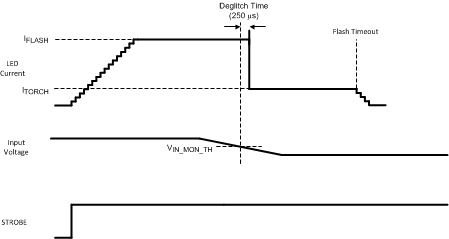 Figure 26. VIN Monitor Waveform
Figure 26. VIN Monitor Waveform
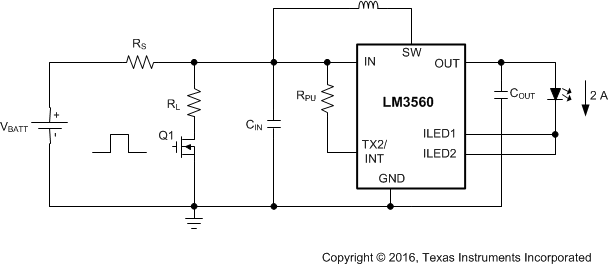
7.3.5.1 Input Voltage Flash Monitor (Flash Current Rising)
A second comparator at the IN pin is available to monitor the input voltage during the flash current turnon (Input voltage flash monitor). Bit [3] of the VIN monitor register enables/disables this feature. With this bit set to 1, the VIN flash monitor is active, and bits [5:4] of the VIN monitor register program the 4 selectable thresholds of (2.9 V, 3 V, 3.1 V, and 3.2 V). The VIN flash monitor operates as follows: during flash current turnon the current sources transitions through each of the lower flash current levels until the target flash current is reached. With the input voltage flash monitor active, if during the flash current turnon the input voltage falls below the VIN flash monitor threshold, the flash current is stopped at the level that the current ramp had risen to, at the time of the VIN flash monitor event. The VIN flash monitor only operates during the ramping up of the flash LED current.
The VIN flash monitor ignores the first 2 flash codes during the flash current turnon. As a result, if the VIN flash monitor is enabled and VIN were to fall below the VIN flash threshold as the LED current ramps up through either of the first two levels, then the flash pulse would not be halted until code number 3 (168.75 mA per current source).
To avoid noise from falsely triggering the VIN flash monitor, this mode incorporates an 8µs de-glitch timer as well as an internal analog filter at the input of the VIN flash monitor comparator. With the VIN flash monitor active, VIN must go below the VIN flash monitor threshold (VIN_FLASH), and remain below it, for 8 µs before the flash current ramp is halted and the VIN flash monitor flag is written.
7.3.6 Last Flash Register
Once the VIN flash monitor is tripped, the flash code that corresponded to the LED current at which the flash current ramp was halted is written to the last flash register. The last flash register is a read-only register and has the lower 4 bits available to latch the code for LED1 and the upper 4 bits to latch the code for LED2.
For example, suppose that the LM3560 is set up for a single LED with a target flash current of 1250 mA and the VIN flash monitor is enabled with the VIN flash monitor threshold set to 3 V (VIN monitor register bits [5:4] = 0, 1). When the STROBE input is brought high, the LED current begins ramping up through the torch and flash current codes at 32 µs/code. As the input current increases, the input voltage at the IN pin of the LM3560 device begins to fall due to the source impedance of the battery. By the time the LED current has reached 1000 mA (code 0x77 or 500 mA per current source), VIN falls below 3 V. The VIN flash monitor then stops the flash current ramp, and the LM3560 continues to proceed with the flash pulse, but at 1000 mA instead of 1250 mA. Figure 28 details this sequence.
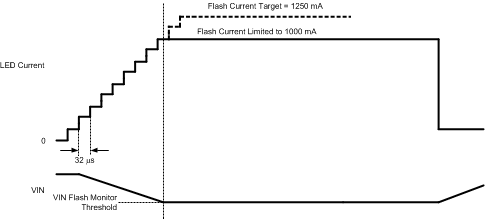 Figure 28. VIN Flash Monitor Example
Figure 28. VIN Flash Monitor Example
7.3.7 LED Voltage Monitor
The LM3560 includes a 4-bit ADC which monitors the LED forward voltage (VLED) and stores the digitized value in bits [3:0] of the VLED monitor register. The highest voltage of VLED1 or VLED2 is automatically sensed and that becomes the sample point for the ADC. Bit 5, the ADC shutdown bit, enables/disables the ADC with the default state set to enable (bit [5] = 0).
7.3.8 ADC Delay
The ADC delay register provides for a programmable delay from 250 µs to 8 ms in steps of 250 µs. This delay is the delay from when the EOC bit goes low to when the VLED monitor samples the LED voltage. In automatic mode the EOC bit goes low when the flash LED current hits its target. In Manual mode the EOC bit goes low at the end of a read back of the VLED monitor register (or when the manual mode bit (bit 4) is re-written with a 1).
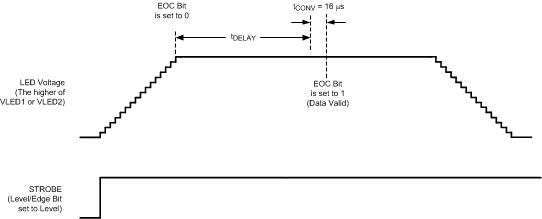 Figure 29. VLED Monitor Automatic Mode
Figure 29. VLED Monitor Automatic Mode
 Figure 30. VLED Monitor Manual Mode
Figure 30. VLED Monitor Manual Mode
7.3.9 Flags Register and Fault Indicators
Eight fault flags are available in the LM3560. These include a flash timeout, a thermal shutdown, an LED failure flag (LED shorted or output going OVP indicating LED open), an LED thermal flag (NTC threshold tripping), a VIN monitor flag, and a VIN flash monitor flag. Additionally, two LED interrupt flag bits (TX1 interrupt and TX2 interrupt) are set when the corresponding interrupt is activated. Reading back a 1 indicates the flagged event has happened. A read of the flags register resets these bits.
7.3.9.1 Flash Timeout
The timeout (TO) flag, (bit [0] of the flags register) reads back a 1 if the LM3560 is active in flash mode and the timeout period expires before the flash pulse is terminated. The flash pulse can be terminated before the timeout period expires by pulling the STROBE pin low (with enable register bit [5] = 0), or by writing a (0,0) to bit [1:0] of the enable register. The TO flag is reset to 0 by pulling HWEN low, removing power to the LM3560, or reading the flags register.
7.3.9.2 Thermal Shutdown
The LM3560 features a thermal shutdown threshold of typically 150°C. When the devices die temperature reaches 150°C the active current sources (LED1 and/or LED2) shuts down, and the TSD flag in the flags register is written high. The device cannot be started up again until the flags register is read back. Once the flags register is read back either current source can be re-enabled into privacy, torch, or flash mode. The thermal shutdown (TSD) circuitry has an internal 250 µs de-glitch timer which helps prevent unwanted noise from falsely triggering a TSD event. However, when the LM3560 is in boost mode at higher flash currents, the de-glitch timer can get reset by the high currents in the GND of the LM3560 device. As a result the internal de-glitch timer of the thermal shutdown can be reset before the TSD event can get latched in. This prevents a TSD event from being triggered until the flash pulse of the LM3560 reaches the end of the flash duration, when the noisy currents have dropped to a lower level. However, once the noise is lower, and a TSD event is triggered, the next flash pulse is not allowed until the flags register is read back. In pass mode the boost switcher is off and the lower noise environment allows the devices TSD circuitry to shut down immediately when the die temperature reaches 150°C.
7.3.9.3 LED Fault
The LED fault flag (bit 2 of the flags register) reads back a 1 if the part is active in flash or torch mode and either LED1 or LED2 experience an open or short condition. An LED open condition is signaled if the OVP threshold is crossed at the OUT pin while the device is in flash, torch, or privacy mode. An LED short condition is signaled if the voltage at LED1 or LED2 goes below 500 mV while the device is in flash, torch, or privacy mode. In an LED open condition there is a 2-µs deglitch time from when the output voltage crosses the OVP threshold to when the LED fault flag is triggered. In an LED short condition there is a 250-µs deglitch time from when the LED voltage falls below 500 mV until the LED fault flag is set. The LED fault flag can only be reset to 0 by pulling HWEN low, cycling power, or by removing the fault condition and reading back the flags register.
7.3.9.4 TX1 and TX2 Interrupt Flags
The TX1 and TX2 interrupt flags (bits [3] and [4]) indicate an interrupt event has occurred on the respective TX inputs. Bit 3 reads back a 1 if TX1 is in TX mode and there has been a TX1 event since the last read of the flags register. Bit 4 reads back a 1 if TX2 is in TX mode and there has been a TX2 event since the last read of the flags register. A read of the flags register automatically resets these bits. A TX event on TX1 or TX2, can be a high-to-low transition or a low-to-high transition depending on the setting of the TX1 and TX2 polarity bits (see Configuration Register 1 (Address 0xE0) bits [6:5]).
7.3.9.5 LED Thermal Fault (NTC Flag)
The NTC flag (bit [5] of the flags register) reads back a 1 if the LM3560 is active in flash or torch mode, the device is in NTC mode, and the voltage at LEDI/NTC has fallen below VTRIP (1V typical). When this has happened, and the LM3560 has been forced into torch mode or LED shutdown (depending on the state of configuration register 2 bit [1), the flags register must be read, and VLEDI/NTC must go above 1 V in order to place the device back in normal operation. (see NTC Mode for more details).
7.3.9.6 VIN Flash Monitor Fault
The VIN flash monitor flag (bit [6] of the flags register) reads back a 1 if the VIN flash monitor is enabled and VIN falls below the programmed VIN flash monitor threshold. This flag must be read back in order to resume normal operation after the LED current has been forced to the lower flash current setting.
7.3.9.7 VIN Monitor Fault
The VIN monitor flag (bit [7] of the flag register) reads back a 1 when the VIN monitor is enabled and VIN falls below the programmed VIN monitor threshold. This flag must be read back and VIN must go above the VIN monitor threshold in order to resume normal operation after the LED current has been forced to torch mode or turned off due to a VIN monitor event.
7.4 Device Functional Modes
7.4.1 Start-Up (Enabling the Device)
Turnon of the LM3560 is done through bits [1:0] of the enable register. These bits enable the device in torch mode, flash mode, or privacy Indicate mode. Additionally, bit 6 of the enable register enables the message indicator at the LEDI/NTC pin. On start-up, when VOUT is less than VIN, the internal synchronous PFET turns on as a current source and delivers 350 mA to the output capacitor. During this time both current sources (LED1, and LED2) are off. When the voltage across the output capacitor reaches 2.2 V the current sources can turn on. At turnon the current sources step through each FLASH and TORCH level until their target LED current is reached (32 µs/step). This gives the device a controlled turnon and limits inrush current from the VIN supply.
7.4.2 Pass Mode
On turnon, when the output voltage charges up to VIN – 150 mV, the LM3560 operates in either pass mode or boost mode. If the voltage difference between VOUT and VLED is less then 300 mV, the device operates in boost mode. If the difference between VOUT and VLED is greater then 300 mV, the device operates in pass mode. In pass mode the boost converter stops switching and the synchronous PFET turns fully on bringing VOUT up to VIN – IIN × RPMOS where RPMOS = 80 mΩ. In pass mode the inductor current is not limited by the peak current limit. In this situation the output current must be limited to 3 A.
7.4.3 Flash Mode
In flash mode the LED current sources (LED1 and LED2) each provide 16 different current levels from typically 62.5 mA (total) to 2 A (total) in steps of 62.5 mA. The flash currents are adjusted via the flash brightness register. Flash mode is activated by writing a (1, 1) to bits [1:0] of the enable register or by enabling the hardware flash input (STROBE) via bit [2] of Configuration Register 1, and then pulling the STROBE pin high (high polarity). Once the flash sequence is activated the active current sources (LED1 and/or LED2) ramps up to their programmed flash current level by stepping through all torch and flash levels (32 µs/step) until the programmed current is reached.
Bit [5] of the enable register (STROBE level/edge bit) determines how the flash pulse terminates after STROBE goes high. With the level/edge bit = 1, the flash current only terminates when it reaches the end of the flash timeout period. With the level/edge bit = 0, flash mode can be terminated by pulling STROBE low, programming bits [1:0] of the enable register with (0,0), or by allowing the flash timeout period to elapse. If the level/edge bit = 0 and STROBE is toggled before the end of the flash timeout period, the timeout period resets. Figure 31 and Figure 32 detail the flash pulse termination for the different level/edge bit settings.
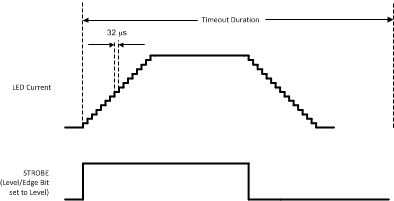 Figure 31. LED Current for Strobe (Level Triggered, Enable Register Bit 5 = 0)
Figure 31. LED Current for Strobe (Level Triggered, Enable Register Bit 5 = 0)
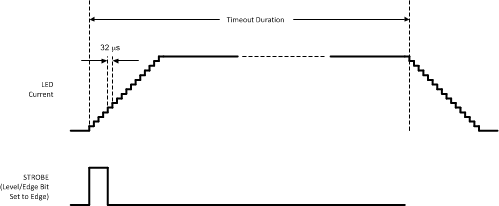 Figure 32. LED Current for Strobe (Edge Triggered, Enable Register Bit 5 = 1)
Figure 32. LED Current for Strobe (Edge Triggered, Enable Register Bit 5 = 1)
After the flash pulse terminates, either by a flash timeout, pulling STROBE low, or disabling it via the I2C-compatible interface, LED1 and LED2 turn completely off. This happens even when torch is enabled via the I2C-compatible interface and the flash pulse is turned on by toggling STROBE. After a flash event ends, bits [1:0] of the enable register are automatically reset with (0, 0). The exception occurs when the privacy terminate bit is low (bit [3]) in the privacy register. In this case, the specific current source that is enabled for privacy mode turns back on after the flash pulse.
7.4.4 Torch Mode
In torch mode the current sources LED1 and LED2 each provide 8 different current levels (Torch Brightness Register Descriptions (Address 0xA0)). Torch mode is activated by setting enable register bits [1:0] to (1, 0). Once torch mode is enabled, the current sources ramps up to the programmed torch current level by stepping through all of the torch currents at (32 µs/step) until the programmed torch current level is reached.
7.4.5 Privacy Indicator Mode
The current sources (LED1 and/or LED2) can also be used as a privacy indicator before and after flash mode. Privacy indicate mode is enabled by setting the enable register bit [1:0] to (0, 1). Privacy mode is configured via the privacy register. This allows the selection of which current source to use as the privacy indicator (either LED1, LED2, or both), whether or not the privacy indicate mode turns off at the end of the flash pulse, the 3 selectable privacy blink periods (tBLINK), and the 8 duty cycle settings for the privacy indicator average current.
The intensity of the LEDs in privacy indicate mode is set by PWM controlling either the lowest torch current level (31.25 mA per current source) or the highest torch current level (250 mA per current source). Bit [2] in the enable register selects between these two levels. Bits [2:0] in the privacy register select the 8 different duty cycles of 10%, 20%, 30%, 40%, 50%, 60%, 70%, and 80%. This enables privacy mode to have a PWM-controlled torch current with a wide number of values (see Table 1 ). The privacy blink options (tBLINK) are set via bit [7:6] of the privacy register. Selectable options are 128 ms, 256 ms, 512 ms, or always on. The blink pulse period is set to 2 × tBLINK. Figure 33 details the timing for the privacy indicate mode timing on ILED1 or ILED2.
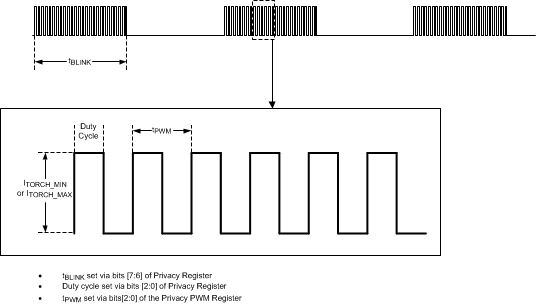 Figure 33. Privacy Indicate Timing
Figure 33. Privacy Indicate Timing
Table 1. Privacy Indicate (With PWM Torch) Possible Current Settings(1)
| PRIVACY CURRENT SETTING (ENABLE REGISTER BIT [2]) 0 = 31.2 5mA peak 1 = 250 mA peak |
PRIVACY INDICATE DUTY CYCLE PRIVACY REGISTER BITS [2:0] see (Table 4) |
ILED1 or ILED2 (SINGLE LED) |
|---|---|---|
| 0 | 000 | 3.125 mA |
| 0 | 001 | 6.25 mA |
| 0 | 010 | 9.375 mA |
| 0 | 011 | 12.5 mA |
| 0 | 100 | 15.625 mA |
| 0 | 101 | 18.75 mA |
| 0 | 110 | 21.875 mA |
| 0 | 111 | 25 mA |
| 1 | 000 | 25 mA |
| 1 | 001 | 50 mA |
| 1 | 010 | 75 mA |
| 1 | 011 | 100 mA |
| 1 | 100 | 125 mA |
| 1 | 101 | 150 mA |
| 1 | 110 | 175 mA |
| 1 | 111 | 200 mA |
7.4.6 GPIO1 Mode
With bit [0] of the GPIO register set to 1, the TX1/TORCH/GPIO1 pin is configured as a logic I/O. In this mode the TX1/TORCH/GPIO1 pin is readable and writable as a logic input/output via bits [2:1] of the GPIO register (see GPIO Register (Address 0x20) for programming the GPIO1 output).
7.4.7 TX2/INT/GPIO2
The TX2/INT/GPIO2 pin has a triple function. In TX2 mode (default) the TX2/INT/GPIO2 pin is an active high flash interrupt. With GPIO register bit [3] = 1 the TX2/INT/GPIO2 pin is configured as general purpose logic I/O. With GPIO register bit [6] = 1, and with the TX2/INT/GPIO2 pin configured as a GPIO2 output, the TX2/INT/GPIO2 pin is an interrupt output.
7.4.8 TX2 Mode
In TX2 mode, when configuration register 1, bit [6] = 0, TX2 is an active low flash interrupt. Under this condition when the LM3560 is engaged in a flash event and TX2 is pulled low, the active current source (LED1 and/or LED2) are forced into torch mode. In TX2 mode with configuration register 1, bit [6] = 1, TX2 is configured for active high polarity. Under this condition, when the LM3560 is engaged in a flash event and TX2 is driven high, the active current source (LED1 and/or LED2) are forced into torch mode. During a TX2 interrupt event, if the TX2 input is disengaged, the LED current returns to the previous flash current level. Figure 21 details the functionality of the TX2 interrupt.
7.4.8.1 TX2 Shutdown
TX2 also has the capability to force shutdown. When bit [0] of configuration register 2 is set to a 1, TX2 forces shutdown when active. For example, if TX2 is configured for TX2 mode with active high polarity, and bit [0] of Configuration Register 2 is set to 1 then when TX2 is driven high, the active current sources (LED1 and/or LED2) is forced into shutdown. Once the active current sources are forced into shutdown by activating TX2, the current sources can only be re-enabled in flash mode if TX2 is pulled low and the flags register is read back. If only the flags register is read back and TX2 is kept high, the device is re-enabled into torch mode and not shut down. This occurs because the TX2 shutdown feature is an edge-triggered event. With active high polarity the TX2 shutdown requires a rising edge at TX2 in order to force the current sources into shutdown. Once shut down, it takes a read back of the flags register and another rising edge at TX2 to force shutdown again. Figure 34 details TX2 shutdown mode.
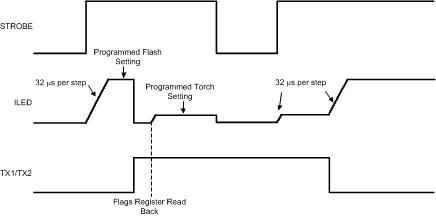 Figure 34. TX1 or TX2 (Force Shutdown) Response
Figure 34. TX1 or TX2 (Force Shutdown) Response
7.4.9 GPIO2 Mode
With bit [3] of the GPIO fegister set to 1, the TX2/INT/GPIO2 pin is configured as a logic I/O. In this mode the TX2/INT/GPIO2 pin is readable and writable as a logic input/output via bits [5:4] of the GPIO register. See Table 8 for programming the GPIO2 output.
7.4.10 Interrupt Output (INT Mode)
The TX2/INT/GPIO2 pin can be reconfigured as an active low interrupt output by setting bit [6] in the GPIO register to 1 and configuring TX2/INT/GPIO2 as a GPIO2 output (bits [4:3] of GPIO register = 11). In this mode, TX2/INT/GPIO2 pulls low when any of these conditions exist:
- The LM3560 is configured for NTC mode (configuration register 1 bit [4] = 1), and the voltage at LEDI/NTC has fallen below VTRIP (1 V typical).
- The LM3560 is configured for VIN monitor mode (VIN monitor register bit [0] = 1), and VIN falls below the programmed VIN monitor threshold.
- The LM3560 is configured for VIN flash monitor mode (VIN monitor register bit [3] = 1), and VIN falls below the programmed VIN flash monitor threshold.
Once INT is pulled low due to any of the above conditions having been met, INT only goes high again if any of the conditions are no longer true and the flags register is read.
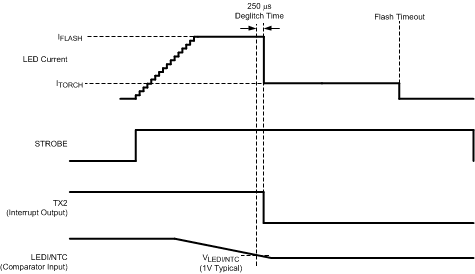 Figure 35. TX2 as an Interrupt Output (During an NTC Event)
Figure 35. TX2 as an Interrupt Output (During an NTC Event)
7.4.11 NTC Mode
Writing a (1) to configuration register 1 bit [4] configures the LEDI/NTC pin for NTC mode. In this mode the indicator current source is disabled, and LEDI/NTC becomes the positive input to the an internal comparator. NTC mode operates as a LED current interrupt that is triggered when the voltage at LEDI/NTC goes below 1 V.
Two actions can be taken when the NTC comparator is tripped. With configuration register 2 bit [1] set to 0 the NTC interrupt forces the LED current from flash mode into torch mode. with configuration register 2 bit [1] set to 1, the NTC interrupt forces the LED current into shutdown.
Whether in NTC force torch or NTC shutdown, in order to re-enter flash mode after an NTC event, two things must occur. First, the NTC input must be above the 1-V threshold. Secondly, the flags register must be read.
To avoid noise from falsely triggering the NTC comparator, this mode incorporates a 250 µs de-glitch timer. With NTC mode active, VLEDI/NTC must go below the trip point (VTRIP) and remain below it for 250 µs before the LEDs are forced into torch mode (or shutdown) and the NTC flag is written.
7.4.12 Alternate External Torch (AET) Mode
With configuration register 2 bit [2] set to 1, the LM3560 is configured for AET mode, and the operation of TX1/TORCH becomes dependent on its occurrence relative to the STROBE input. In this mode, if TX1/TORCH goes high first, then STROBE goes high, the LEDs are forced into torch mode with no timeout. In this mode, if TX1/TORCH goes high after STROBE has gone high, then the TX1/TORCH pin operates as a normal LED current interrupt (TX1), and the LEDs turn off at the end of the timeout duration (see Figure 36).
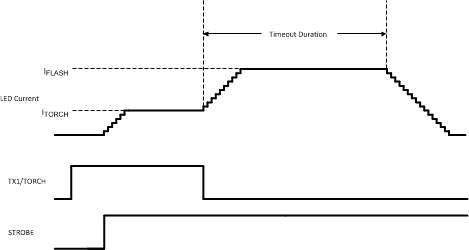 Figure 36. AET Mode Timing
Figure 36. AET Mode Timing
7.4.13 Automatic Conversion Mode
With the ADC enabled, a conversion is performed each time a flash pulse is started. When a flash pulse is started bit [6] of the VLED monitor register end-of-conversion (EOC) bit is automatically written with a 0. At the end of the conversion, bit [6] goes high signaling that the VLED data is valid. A read back of the VLED monitor register clears the EOC bit. Figure 26 shows the VLED monitor automatic conversion.
7.4.14 Manual Conversion Mode
When this bit is set high the EOC bit (bit [6]) goes low, and a conversion is performed. When the conversion is complete, the EOC bit goes high again. Subsequent conversions are performed in manual mode by reading back the VLED monitor register, which resets the EOC bit and starts another conversion (see Figure 30).
7.5 I2C-Compatible Interface
7.5.1 START and STOP Conditions
The LM3560 is controlled via an I2C-compatible interface. START and STOP conditions classify the beginning and end of the I2C session. A START condition is defined as SDA transitioning from HIGH-to-LOW while SCL is HIGH. A STOP condition is defined as SDA transitioning from LOW-to-HIGH while SCL is HIGH. The I2C master always generates the START and STOP conditions.
 Figure 37. START and STOP Sequences
Figure 37. START and STOP Sequences
The I2C bus is considered busy after a START condition and free after a STOP condition. During data transmission the I2C master can generate repeated START conditions. A START and a repeated START condition are equivalent function-wise. The data on SDA must be stable during the HIGH period of the clock signal (SCL). In other words, the state of SDA can only be changed when SCL is LOW. Figure 38 shows the SDA and SCL signal timing for the I2C-compatible bus. See Electrical Characteristics for timing values.
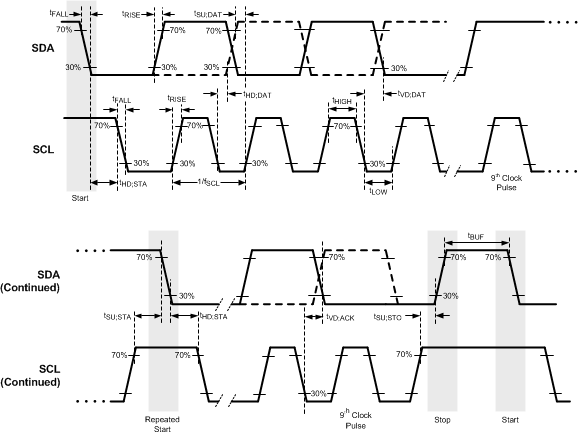 Figure 38. I2C-Compatible Timing
Figure 38. I2C-Compatible Timing
7.5.2 I2C-Compatible Chip Address
The device address for the LM3560 is 1010011 (0xA7 for read and 0xA6 for write). After the START condition, the I2C master sends the 7-bit address followed by an eighth read or write bit (R/W). R/W = 0 indicates a WRITE and R/W = 1 indicates a READ. The second byte following the device address selects the register address to which the data is written. The third byte contains the data for the selected register.
 Figure 39. Device Address
Figure 39. Device Address
7.5.3 Transferring Data
Every byte on the SDA line must be eight bits long, with the most significant bit (MSB) transferred first. Each byte of data must be followed by an acknowledge bit (ACK). The acknowledge related clock pulse (9th clock pulse) is generated by the master. The master releases SDA (HIGH) during the 9th clock pulse (write mode). The LM3560 pulls down SDA during the 9th clock pulse, signifying an acknowledge. An acknowledge is generated after each byte has been received.
7.6 Register Descriptions
Table 2. LM3560 Internal Registers
| REGISTER NAME | INTERNAL HEX ADDRESS | POWER ON/RESET VALUE |
|---|---|---|
| Enable | 0x10 | 0x18 |
| Privacy | 0x11 | 0x58 |
| Indicator | 0x12 | 0x00 |
| Indicator Blinking | 0x13 | 0x00 |
| Privacy PWM | 0x14 | 0xF8 |
| GPIO | 0x20 | 0x80 |
| VLED Monitor (ADC) | 0x30 | 0x80 |
| ADC Delay | 0x31 | 0x90 |
| VIN Monitor | 0x80 | 0xC0 |
| Last Flash | 0x81 | 0x00 |
| Torch Brightness | 0xA0 | 0x52 |
| Flash Brightness | 0xB0 | 0xDD |
| Flash Duration | 0xC0 | 0xEF |
| Flags | 0xD0 | 0x00 |
| Configuration 1 | 0xE0 | 0x6B |
| Configuration 2 | 0xF0 | 0xE0 |
7.6.1 Enable Register (Address 0x10)
Bits [1:0] of the enable register controls the on/off state of torch mode, flash mode, and privacy indicate mode. Bit 2 selects the peak current setting for privacy indicate mode (maximum or minimum torch current). Bits [4:3] turn on/off the main current sources (LED1 and LED2). Bit [5] sets the level or edge control for the STROBE input. Bits 7 and 6 control the Indicator current source (see Table 3).
Table 3. Enable Register Descriptions
| Bit 7 (EN Blink) |
Bit 6 (EN Message Indicator) |
Bit 5 (STROBE Level/Edge) |
Bit 4 (LED2 ENABLE) |
Bit 3 (LED1 Enable) |
Bit 2 (Privacy Mode Peak Current Setting) |
Bit 1 (EN1) |
Bit 0 (EN0) |
|---|---|---|---|---|---|---|---|
| 0 = Message indicator blinking function is disabled(1) (default)
1 = Message indicator blinking function is enabled. the message indicator blinks the pattern programmed in the indicator register and indicator blinking register |
0 = Message Indicator is disabled (Default)
1= Message Indicator is enabled. |
0 = (Level Sensitive) When STROBE goes high, the flash current turns on and remain on for the duration the STROBE pin is held high or when the flash timeout occurs, whichever comes first. (default) 1 = (Edge Triggered) When STROBE goes high, the flash current turns on and remain on for the duration of the flash time-out. |
0 = LED2 off 1 = LED2 on (default) |
0 = LED1 off 1 = LED1 on (default) |
0 = 31.25 mA (default)
1 = 250 mA |
Enable Bits
00 = Current sources are shutdown (default) 01 = Privacy indicator mode 10 = Torch mode 11 = Flash mode (bits reset at timeout) |
|
7.6.2 Privacy Register (Address 0x11)
The privacy register contains the bits that control which current source is used for the privacy indicator (LED1 or LED2 or both), whether the privacy indicator turns off or remains on after the flash pulse terminates, and the duty cycle settings (between 10% and 80%) for setting the average privacy LED current (see Table 4 ).
Table 4. Privacy Register
| Bit 7 (Blink 2) |
Bit 6 (Blink 1) |
Bit 5 (LED2 Privacy) |
Bit 4 (LED1 Privacy) |
Bit 3 (Privacy Terminate) |
Bit 2 (PD2) | Bit 1 (PD1) | Bit 0 (PD0) |
| tBLINK
00 = No Blinking 01 = 128 ms Blink Period (Default) 10 = 256 ms Blink Period 11 = 512 ms Blink Period |
0 = LED2 is off for privacy mode (Default)
1 = LED2 is on for privacy mode |
0 = LED1 is off for privacy mode 1 = LED1 is on for privacy mode (Default) |
0 = Privacy mode turns back on at the end of the flash pulse 1 = Privacy mode remains off at the end of the flash pulse (Default) |
Privacy mode current levels (% of minimum or maximum torch current, depending on bit [2] of enable register) 000 = 10% (Default) 001 = 20% 010 = 30% 011 = 40% 100 = 50% 101 = 60% 110 = 70% 111 = 80% |
|||
7.6.3 Indicator Register (Address 0x12)
The Indicator register contains the bits which control the following:
- Indicator current level
- Pulse width
- Ramp times for turnon and turnoff of the indicator current source (see Figure 40 for the message indicator timing diagram).
Table 5. Indicator Register
| Bit 7 (R2) | Bit 6 (R1) | Bit 5 (P3) | Bit 4 (P2) | Bit 3 (P1) | Bit 2 (I3) | Bit 1 (I2) | Bit 0 (I1) |
|---|---|---|---|---|---|---|---|
| (tR and tF) 00 = 78 ms (default) 01 = 156 ms 10 = 312 ms 11 = 624 ms |
(PERIOD#) 000 = 0 (default) 001 = 1 010 = 2 011 = 3 100 = 4 101 = 5 110 = 6 111 = 7 |
(IIND) 000 = 2.25 mA (default) 001 = 4.5 mA 010 = 6.75 mA 011 = 9 mA 100 = 11.25 mA 101 = 13.5 mA 110 = 15.75 mA 111 = 18 mA |
|||||
7.6.4 Indicator Blinking Register (Address 0x13)
The indicator blinking register contains the bits which control the following:
- Number of periods (tPERIOD = tR + tF + 2 × tPULSE )
- Active Time (tACTIVE = tPERIOD × PERIOD# )
- Blank Time (tBLANK = tACTIVE × BLANK#)
- (see Figure 40)
Table 6. Indicator Blinking Register
| Bit 7 (N/A) | Bit 6 (M3) | Bit 5 (M2) | Bit 4 (M1) | Bit 3 (PW4) | Bit 2 (PW3) | Bit 1 (PW2) | Bit 0 (PW1) |
|---|---|---|---|---|---|---|---|
| Not used | BLANK# 0000 = 0 (default) 0001 = 1 0010 = 2 0011 = 3 0100 = 4 0101 = 5 0110 = 6 0111 = 7 1000 = 8 1001 = 9 1010 = 10 1011 = 11 1100 = 12 1101 = 13 1110 = 14 1111 = 15 |
Pulse time (tPULSE) 0000 = 0 (default) 0001 = 32 ms 0010 = 64 ms 0011 = 92 ms 0100 = 128 ms 0101 = 160 ms 0110 = 196 ms 0111 = 224 ms 1000 = 256 ms 1001 = 288 ms 1010 = 320 ms 1011 = 352 ms 1100 = 384 ms 1101 = 416 ms 1110 = 448 ms 1111 = 480 ms |
|||||
 Figure 40. Message Indicator Timing Diagram
Figure 40. Message Indicator Timing Diagram
7.6.5 Privacy PWM Period Register (Address 0x14)
The privacy PWM register contains the bits to control the PWM period for the privacy indicate mode (see Table 7).
Table 7. Privacy PWM Period Register
| Bits 7-3
(Not Used) |
Bit 2
(P3) |
Bit 1
(P2) |
Bit 0
(P1) |
||||
| 000 = 5.12 ms (default)
001 = 2.56 ms 010 = 1.28 ms 011 = 640 µs 1XX = 320 µs |
|||||||
7.6.6 GPIO Register (Address 0x20)
The GPIO register contains the control bits which change the state of the TX1/TORCH/GPIO1 pin and the TX2/INT/GPIO2 pins to general purpose I/Os (GPIOs). Additionally, bit 6 of this register contains the interrupt configuration bit. Table 8 describes the bit description and functionality of the GPIO register. To configure the TX1 or TX2 pins as GPIO outputs an initial double write is required to register 0x20. For example, to configure TX2 to output a logic high, an initial write of 0xB8 would need to occur twice, to force GPIO2 low. Subsequent writes to GPIO2 after the initial set-up, only requires a single write. To read back the GPIO inputs, a write then a read of register 0x20 must occur each time the data is read. For example, if GPIO2 is set up as a GPIO input and the GPIO2 input has then changed state, first a write to 0x20 must occur, then the following read back of register 0x20 shows the updated data. When configuring TX2 as an interrupt output, the TX2/GPIO2/INT pin must first be configured as a GPIO output (double write). For example, to configure TX2/GPIO2/INT for INT mode a write of 0xF8 to register 0x20 must be done twice.
Table 8. GPIO Register
| Bit 7 (Not Used) |
Bit 6 (TX2/INT/GPIO2 Interrupt Enable) |
Bit 5 (TX2/INT/GPIO2 data) |
Bit 4 (TX2/INT/GPIO2 data direction) |
Bit 3 (TX2/INT/GPIO2 Control) |
Bit 2 (TX1/TORCH/GPIO1 data) |
Bit 1 (TX1/TORCH/GPIO1 data direction) |
Bit 0 (TX1/TORCH/GPIO1 Control) |
|---|---|---|---|---|---|---|---|
| N/A | 0 = TX2/INT/GPIO2 is configured according to bit 3 of this register (default) | This bit is the read or write data for the TX2/INT/GPIO2 pin in GPIO mode | 0 = TX2/INT/GPIO2 is a GPIO Input (default) | 0 = TX2/INT/GPIO is configured as a TX interrupt (default) | This bit is the read or write data for the GPIO1 pin in GPIO mode | 0 = TX1/TORCH/GPIO1 is a GPIO input (default) | 0 = TX1/TORCH/GPIO1 pin is configured as TX interrupt(default) |
| 1 = with bits [4:3] = 11, TX2/INT/GPIO2 is an interrupt output. See Interrupt Output (INT Mode). | 1 = TX2/INT/GPIO2 is a GPIO output | 1 = TX2/INT/GPIO2 is configured as a GPIO | 1 TX1/TORCHGPIO1 is an output | 1 = TX1/TORCH/GPIO1 pin is configured as a GPIO |
7.6.7 LED Forward Voltage ADC (VLED Monitor Register, Address 0x30)
The VLED monitor register controls the internal 4 bit analog to digital converter. Bits [3:0] of this register contain the 4-bit data of the LED voltage. This data is the digitized voltage of the highest of either VLED1 to GND or VLED2 to GND. Bit [4] is the manual mode enable which provides for a manual conversion of the ADC. In manual mode the automatic conversion is still performed. In automatic conversion mode a conversion is performed each time a flash pulse is initiated. Bit [5] is the ADC shutdown bit. Bit [6] signals the end of conversion. This is a read-only bit that goes high when a conversion is complete and data is ready. A read of the VLED monitor register clears the end-of-conversion bit (see Table 9).
Table 9. VLED Monitor Register Descriptions
| Bit 7 (Not Used) |
Bit 6 (End of Conversion) |
Bit 5 (ADC Shutdown) |
Bit 4 (Manual Mode Enable) |
Bit 3 (ADC3) |
Bit 2 (ADC2) |
Bit 1 (ADC1) |
Bit 0 (ADC0) |
|---|---|---|---|---|---|---|---|
| N/A | 0 = Conversion in progress(default) | 0 = ADC is enabled (default) |
0 = Manual mode disabled (default) |
0000 = (VLED < 2.8 V) (default)
0001 = (2.8 V ≤ VLED < 2.9 V) 0010 = (2.9 V ≤ VLED < 3 V) 0011 = (3 V ≤ VLED < 3.1 V) 0100 = (3.1 V ≤ VLED < 3.2 V) 0101 = (3.2 V ≤ VLED < 3.3 V) 0110 = (3.3 V ≤ VLED < 3.4 V) 0111 = (3.4 V ≤ VLED < 3.5 V) 1000 = (3.5 V ≤ VLED < 3.6 V) 1001 = (3.6 V ≤ VLED < 3.7 V) 1010 = (3.7 V ≤ VLED < 3.8 V) 1011 = (3.8 V ≤ VLED < 3.9 V) 1100 = (3.9 V ≤ VLED < 4 V) 1101 = (4.0 V ≤ VLED < 4.1 V) 1110 = (4.1 V ≤ VLED < 4.2 V) 1111 = (4.2 V ≤ VLED) |
|||
| 1 = Conversion done | 1 = ADC is shutdown, no conversion is performed | 1 = manual mode is enabled | |||||
7.6.8 ADC Delay Register (Address 0x31)
The ADC delay register programs the delay from when the EOC bit goes low to when a conversion is initiated. This delay applies to both manual mode and automatic mode. Bit 5 is the no-delay bit and can set the delay to effectively 0.
Table 10. ADC Delay Register Descriptions
| Bit 7 (Not Used) |
Bit 6 (Not used) |
Bit 5 (No Delay) | Bit 4 (D1) | Bit 3 (D2) | Bit 2 (D3) | Bit 1 (D4) | Bit 0 (D5) |
|---|---|---|---|---|---|---|---|
| N/A | 0 = Delay is set by bits [4:0](default) | Bits [4:0] programs the delay from when the EOC bit goes low to when a conversion is started (250 µs/step). 00000 = 250 µs : 01111 = 4 ms (default) : 11111 = 8 ms |
|||||
| 1 = no delay from when the EOC goes low to when the conversion is started. | |||||||
7.6.9 VIN Monitor Register (Address 0x80)
The VIN monitor register controls the enable bit for the VIN monitor, the threshold select for the VIN monitor, the enable bit for the VIN flash monitor, and the threshold select for the VIN flash monitor (see Table 11).
Table 11. VIN Monitor Register Descriptions
| Bit 7 (Not used) |
Bit 6 (Not used) |
Bit 5 (VIN Flash Monitor Threshold 1) |
Bit 4 (VIN Flash Monitor Threshold 2) |
Bit 3 (VIN Flash Monitor enable) |
Bit 2 (VIN Monitor Threshold1) |
Bit 1 (VIN Monitor Threshold0) |
Bit 0 (VIN Monitor Enable) |
|---|---|---|---|---|---|---|---|
| N/A | 00= 2.9 V (default)
01 = 3.0V 10 = 3.1V 11 = 3.2V |
0 = VIN flash monitor is disabled (default) | 00 = 2.9 V Default
01= 3.0V 10 = 3.1V 11 = 3.2V |
0 = VIN monitor disabled (default) | |||
| 1 = VIN flash monitor is enabled | 1 = VIN monitor is enabled | ||||||
7.6.10 Last Flash Register (Address 0x81)
The last flash register is a read-only register, which is loaded with the flash code corresponding to the flash level that the LM3560 device was at if any of the following events happen:
- Voltage at LEDI/NTC falling below VTRIP with the device in NTC mode (configuration register 1 bit [4] = 1);
- Input voltage falling below the programmed VIN monitor threshold with device in VIN monitor mode (VIN monitor register bit [0] = 1); or
- Input voltage falling below the programmed VIN flash monitor threshold with the device in VIN flash monitor mode (VIN monitor register bit [3] = 1).
The last flash register is updated at the same time that the corresponding flag bit is written to the flags register. This results in a delay of 250 µs from when VLEDI/NTC (NTC mode) crosses VTRIP, or VIN (VIN monitor enabled) crosses the VIN_TH. During VIN flash monitor there is a 8-µs deglitch time so the VIN flash monitor flag is written (and the last flash register is updated) 8 µs after VIN falls below VIN_FLASH.
Table 12. Last Flash Register Descriptions
| Bit 7 (LF2A) |
Bit 6 (LF2B) |
Bit 5 (LF2C) |
Bit 4 (LF2D) |
Bit 3 (LF1A) |
Bit 2 (LF1B) |
Bit 1 (LF1C) |
Bit 0 (LF1D) |
|---|---|---|---|---|---|---|---|
| These bits are read only and represent the flash current code for LED2 that the LM3560 was at during the interrupt. 0000 = 62.5 mA 0001 = 125 mA 0010 = 187.5 mA 0011 = 250 mA 0100 = 312.5 mA 0101 = 375 mA 0110 = 437.5 mA 0111 = 500 mA 1000 = 562.5 mA 1001 = 625 mA 1010 = 687.5 mA 1011 = 750 mA 1100 = 812.5 mA 1101 = 875 mA 1110 = 937.5 mA 1111 = 1000 mA |
These bits are read only and represent the flash current code for LED1 that the LM3560 was at during the interrupt. 0000 = 62.5 mA 0001 = 125 mA 0010 = 187.5 mA 0011 = 250 mA 0100 = 312.5 mA 0101 = 375 mA 0110 = 437.5 mA 0111 = 500 mA 1000 = 562.5 mA 1001 = 625 mA 1010 = 687.5 mA 1011 = 750 mA 1100 = 812.5 mA 1101 = 875 mA 1110 = 937.5 mA 1111 = 1000 mA |
||||||
7.6.11 Torch Brightness Register Descriptions (Address 0xA0)
Bits [2:0] of the torch brightness register set the torch current for LED1. Bits [5:3] set the torch current for LED2 (see Table 13).
Table 13. Torch Brightness Register Descriptions
| Bit 7 (N/A) |
Bit 6 (N/A) |
Bit 5 (TC2A) |
Bit 4 (TC2B) |
Bit 3 (TC2C) |
Bit 2 (TC1A) |
Bit 1 (TC1B) |
Bit 0 (TC1C) |
|---|---|---|---|---|---|---|---|
| (Not Used) | LED2 Torch Current Select Bits
000 = 31.25 mA (62.5 mA total) 001 = 62.5 mA (125 mA total) 010 =93.75 mA (187.5 mA total) default 011 = 125 mA (250 mA total) 100 = 156.25 mA (312.5 mA total) 101 = 187.5 mA (375 mA total) 110 = 218.75 mA (437.5 mA total) 111 = 250 mA (500 mA total) |
LED1 Torch Current Select Bits
000 = 31.25 mA (62.5 mA total) 001 = 62.5 mA (125 mA total) 010 =93.75 mA (187.5 mA total) default 011 = 125 mA (250 mA total) 100 = 156.25 mA (312.5 mA total) 101 = 187.5 mA (375 mA total) 110 = 218.75 mA (437.5 mA total) 111 = 250 mA (500 mA total) |
|||||
7.6.12 Flash Brightness Register (Address 0xB0)
Bits [3:0] of the flash brightness register set the flash current for LED1. Bits [7:4] set the flash current for LED2 (see Table 14).
Table 14. Flash Brightness Register Descriptions
| Bit 7 (FC2A) |
Bit 6 (FC2B) |
Bit 5 (FC2C ) |
Bit 4 (FC2D) |
Bit 3 (FC1A ) |
Bit 2 (FC1B) |
Bit 1 (FC1C) |
Bit 0 (FC1D) |
|---|---|---|---|---|---|---|---|
| Flash Current Select Bits
0000 = 62.5 mA 0001 = 125 mA 0010 = 187.5 mA 0011 = 250 mA 0100 = 312.5 mA 0101 = 375 mA 0110 = 437.5 mA 0111 = 500 mA 1000 = 562.5 mA 1001 = 625 mA 1010 = 687.5 mA 1011 = 750 mA 1100 = 812.5 mA 1101 = 875 mA (default) 1110 = 937.5 mA 1111 = 1000 mA |
Flash Current Select Bits
0000 = 62.5 mA 0001 = 125 mA 0010 = 187.5 mA 0011 = 250 mA 0100 = 312.5 mA 0101 = 375 mA 0110 = 437.5 mA 0111 = 500 mA 1000 = 562.5 mA 1001 = 625 mA 1010 = 687.5 mA 1011 = 750 mA 1100 = 812.5 mA 1101 = 875 mA (default) 1110 = 937.5 mA 1111 = 1000 mA |
||||||
7.6.13 Flash Duration Register (Address 0xC0)
Bits [4:0] of the flash duration register set the flash timeout duration. Bits [6:5] set the switch current limit (see Table 15).
Table 15. Flash Duration Register Descriptions
| Bit 7 (Not used) |
Bit 6 (CL1) |
Bit 5 (CL0) |
Bit 4 (T4) |
Bit 3 (T3) |
Bit 2 (T2) |
Bit 1 (T1) |
Bit 0 (T0) |
|---|---|---|---|---|---|---|---|
| N/A | Current Limit Select Bits
00 = 1.6-A peak current limit 01 = 2.3-A peak current limit 10 = 3-A peak current limit 11 = 3.6-A peak current limit (default) |
Flash Time-out Select Bits
00000 = 32 ms time-out 00001 = 64 ms time-out 00010 = 96 ms time-out 00011 = 128 ms time-out 00100 = 160 ms time-out 00101 = 192 ms time-out 00110 = 224 ms time-out 00111 = 256 ms time-out 01000 = 288 ms time-out 01001 = 320 ms time-out 01010 = 352 ms time-out 01011 = 384 ms time-out 01100 = 416 ms time-out 01101 = 448 ms time-out 01110 = 480 ms time-out 01111 = 512 ms time-out (default) 10000 = 544 ms time-out 10001 = 576 ms time-out 10010 = 608 ms time-out 10011 = 640 ms time-out 10100 = 672 ms time-out 10101 = 704 ms time-out 10110 = 736 ms time-out 10111 = 768 ms time-out 11000 = 800 ms time-out 11001 = 832 ms time-out 11010 = 864 ms time-out 11011 = 896 ms time-out 11100 = 928 ms time-out 11101 = 960 ms time-out 11110 = 992 ms time-out 11111 = 1024 ms time-out |
|||||
7.6.14 Flags Register (Address 0xD0)
The flags register holds the flag bits indicating flash timeout, thermal shutdown, LED fault (open or short), TX interrupts (TX1 and TX2), LED thermal fault (NTC), VIN monitor trip, and VIN flash monitor trip. All flags are cleared on read back of the flags register. (See Table 16).
Table 16. Flags Register Descriptions
| Bit 7 (VIN Monitor) |
Bit 6 (VIN Flash Monitor) |
Bit 5 (NTC Fault) |
Bit 4 (TX2 Interrupt) |
Bit 3 (TX1 Interrupt ) |
Bit 2 (LED Fault) |
Bit 1 (Thermal Shutdown) |
Bit 0 (Flash Time-out) |
|---|---|---|---|---|---|---|---|
| 0 = VIN is above the VIN monitor threshold or VIN monitor threshold is disabled. (default) | VIN did not fall below the VIN flash monitor threshold during flash pulse turnon or VIN flash monitor is disabled (default) | 0 = LEDI/NTC pin is above 1 V(default) | 0 = TX2 has not changed state (default) | 0 = TX1 has not changed state (default) | 0 = Proper LED operation (default) | 0 = Die temperature below thermal shutdown limit (default) | 0 = Flash time-out did not expire (default) |
| 1 = VIN monitor is enabled and VIN has fallen below the programmed threshold | 1 = VIN flash monitor is enabled and VIN fell below the programmed VIN monitor threshold during flash pulse turn-on | 1 = NTC mode is enabled and LEDI/NTC has fallen below 1 V | 1 = TX2 has changed state (TX2 mode only) | 1 = TX1 has changed state (TX1 mode only) | 1 = LED Failed (Open or Short) | 1 = die temperature has crossed the thermal shutdown threshold | 1 = Flash time-out expired |
7.6.15 Configuration Register 1 (Address 0xE0)
Configuration register 1 holds the STROBE Enable bit, the STROBE polarity bit, the NTC Enable bit, the polarity selection bit for TX1 and TX2, and the hardware torch enable bit (see Table 17).
Table 17. Configuration Register 1 Descriptions
| Bit 7 (Hardware Torch Mode Enable) | Bit 6 (TX2 Polarity) |
Bit 5 (TX1 Polarity) |
Bit 4 (NTC Mode Enable) |
Bit 3 (STROBE Polarity) |
Bit 2 (STROBE Input Enable) |
Bit 1 (Not Used) |
Bit 0 (Not Used) |
|---|---|---|---|---|---|---|---|
| 0 = TX1/TORCH is a TX input (default) | 0 = TX2 is configured for active low polarity | 0 = TX1 is configured for active low polarity | 0 = LEDI/NTC pin is configured as an indicator output (default) | 0 = STROBE Input Enable is active low. Pulling STROBE low turns on flash current | 0 = STROBE input disabled (Default) | N/A | N/A |
| 1 = TX1/TORCH pin is a hardware TORCH enable. This bit is reset to 0 after a flash pulse. | 1 =TX2 pin is configured for active high polarity (default) | 1 = TX1 is configured for active high polarity (default) | 1 = LEDI/NTC is configured as a comparator input for an NTC thermistor | 1 = STROBE Input is active high. Pulling STROBE high turns on flash current (default) | 1 = STROBE Input Enabled |
7.6.16 Configuration Register 2 (Address 0xF0)
Configuration register 2 holds the TX2 shutdown select bit, the NTC shutdown select bit, the AET mode select bit, the VIN monitor shutdown bit, and the TX1 shutdown bit (see Table 18).
Table 18. Configuration Register 2 Bit Descriptions
| Bit 7 (Not used) |
Bit 6 (Not used) |
Bit 5 (Not used) |
Bit 4 (TX1 Shutdown) |
Bit 3 (VIN Monitor Shutdown) |
Bit 2 (AET mode) |
Bit 1 (NTC Shutdown) |
Bit 0 (TX2 Shutdown) |
|---|---|---|---|---|---|---|---|
| N/A | N/A | N/A | 0 = TX1 interrupt forces the LED current to the programmed torch current level (default) | 0 = VIN falling below the programmed VIN monitor threshold forces the LED current into the programmed torch current level (default) | 0 = AET abled (default) | 0 = Voltage at LEDI/NTC falling below VTRIP forces the LED current to the programmed torch current level.(default) | 0 = TX2 interrupt forces the LED current to the programmed torch current level (default) |
| 1 = TX1 interrupt forces the LED current into shutdown. | 1 = VIN falling below the programmed VIN monitor threshold forces the LED current into shutdown. | 1 = AET mode enabled | 1 = Voltage at LEDI/NTC falling below VTRIP forces the LED current into shutdown. | 1 = TX2 interrupt forces the LED current into shutdown. |